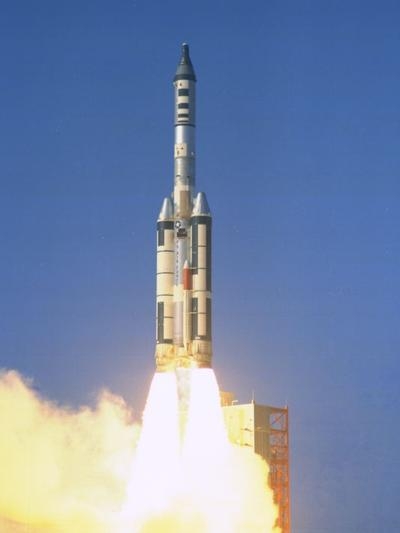Tue, Nov 08, 2016
But Manned Orbiting Laboratory Was A Short-Lived Idea
Last week, the U.S. Air Force celebrated the 50th anniversary of the only launch in the Manned Orbiting Laboratory (MOL) program. The November 3 flight would determine if a modified Gemini capsule could survive re-entry after a hatch had been cut into its heat shield.

The hatch would have allowed astronauts to move between the capsule and a planned laboratory situated below.
While the capsule survived the 33 minute suborbital flight, the program did not.
Florida today reports that the program was cancelled less than three years later in 1969.
But the capsule is a one-of-a-kind artifact. It is the only Mercury, Gemini, or Apollo capsule ever to fly into space twice. It was also the only capsule to fly in space carrying U.S. Air Force markings.
According to the National Reconnaissance Office, The Manned Orbiting Laboratory (MOL) was a 1960s Air Force program with the ostensible mission to place military personnel in orbit to conduct scientific experiments to determine the “military usefulness” of placing man into space and the techniques and procedures for doing so if the need ever arose. The actual, classified, mission of the MOL program was to place a manned surveillance satellite into orbit. At the time, several military and contractor studies estimated that manned surveillance satellites could acquire photographic coverage of the Soviet Union with resolution better than the best system at the time (the first generation Gambit satellite). Additionally, the Air Force billed the MOL as a reconnaissance system that could more efficiently and quickly adjust coverage for crises and targets of opportunity than unmanned systems. The Air Force controlled development of the satellite, which was consistent with MOL’s unclassified
mission, while the NRO ran development of the covert reconnaissance mission of the program, including the camera system and other subsystems.
The MOL-B test flight came less than 10 years after the Soviets launched Sputnik and sparked the space race. But satellite technology advanced quickly, and made a manned program unnecessary.
(NASA Image)
More News
From 2023 (YouTube Version): Legacy of a Titan Robert (Bob) Anderson Hoover was a fighter pilot, test pilot, flight instructor, and air show superstar. More so, Bob Hoover was an i>[...]
Get The Latest in Aviation News NOW on Instagram Are you on Instagram yet? It's been around for a few years, quietly picking up traction mostly thanks to everybody's new obsession >[...]
Aero Linx: B-52H Stratofortress The B-52H Stratofortress is a long-range, heavy bomber that can perform a variety of missions. The bomber is capable of flying at high subsonic spee>[...]
Altimeter Setting The barometric pressure reading used to adjust a pressure altimeter for variations in existing atmospheric pressure or to the standard altimeter setting (29.92).>[...]
"Knowing that we play an active part in bettering people's lives is extremely rewarding. My team and I are very thankful for the opportunity to be here and to help in any way we ca>[...]
 Classic Aero-TV: Remembering Bob Hoover
Classic Aero-TV: Remembering Bob Hoover ANN FAQ: Follow Us On Instagram!
ANN FAQ: Follow Us On Instagram! ANN's Daily Aero-Linx (05.15.24)
ANN's Daily Aero-Linx (05.15.24) ANN's Daily Aero-Term (05.15.24):Altimeter Setting
ANN's Daily Aero-Term (05.15.24):Altimeter Setting Aero-News: Quote of the Day (05.16.24)
Aero-News: Quote of the Day (05.16.24)



